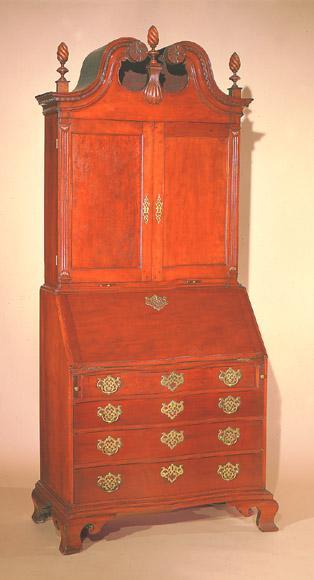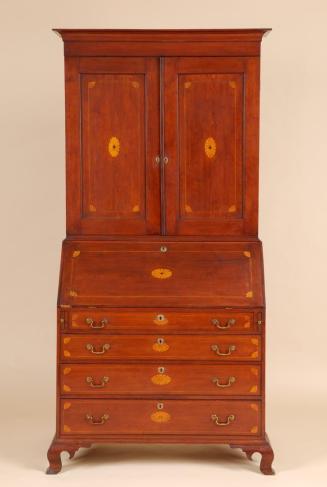Desk and Bookcase
Furniture MakerProbably made by
Calvin Willey
(American, 1769-after 1830)
Date1785-1790
MediumCherry primary wood, eastern white pine secondary wood, brass hardware
DimensionsPrimary Dimensions (overall height x width of lower case x depth of lower case): 88 x 40 3/4 x 22 1/4in. (223.5 x 103.5 x 56.5cm)
Other (height x width x depth of lower case): 44 1/4 x 40 3/4 x 22 1/4in. (112.4 x 103.5 x 56.5cm)
Other (height x width x depth of upper case): 44 x 39 x 11 7/8in. (111.8 x 99.1 x 30.2cm)
ClassificationsFurniture
Credit LineGift of Frederick K. and Margaret R. Barbour
Object number1963.6.1
DescriptionCherry desk and bookcase with a swan's neck pediment, and a slant front desk with serpentine drawer fronts, in the Chippendale, or rococo, style. The desk and bookcase has local characteristics associated with the Colchester style, specifically the Calvin Willey group. The swan's neck pediment has a conforming roof, or bonnet top, which is open at the center. Each upper end of the pediment molding terminates in a carved, four-lobe pinwheel rosette. The pediment molding is decorated with dentils. At the top of the desk and bookcase, there are three finials, each in the shape of a flame. The center finial sits on a plinth with an applied, inverted, projecting shell. The two smaller side finials each sit on a small, fluted, rectangular plinth. The bookcase has a pair of doors with recessed center panels flanked by a stop-fluted pilaster, or fluted flat column with reeding on the bottom half. Each pilaster has applied shells, or demilunes, at the top and bottom. Below each bookcase door is a candle slide, a narrow shelf that extends forward to hold a candle. The bookcase fits inside the mid-molding of the slant-front desk top. The desk arrangement consists of a slant front above four graduated drawers, each with a serpentine front. The serpentine shaping consists of two recessed curves separated by a center projecting curve. The top drawer is slightly narrower and is flanked by lopers, or thin boards that pull out to form a support for the top when open. The ogee bracket feet have scrolled returns that terminate in a carved scroll.
The interior arrangement of the bookcase includes one full-width shelf and two full-height vertical partitions. A short vertical partition creates a row of four pigeonholes at the top. Each pigeonhole has a bracket shaped with a cyma curve, or S-curve, and a reverse cyma curve. The vertical partitions that separate the pigeonholes have a shaped front edge, consisting of a C-curve over a half arch. The two outer sections created by the vertical partitions have a fixed shelf; the center section of the bookcase has two moveable shelves. The interior arrangement of the desk consists of a center shell-carved drawer flanked by four pigeonholes above two rows of drawers. Each pigeonhole has a bracket shaped with a cyma curve and a reverse cyma curve. Below this is the top row of drawers that contains give drawers in a line that are shaped to form an undulating curve along the interior of the desk. The center drawer has a recessed curve that corresponds to the inward curve of the carved shell drawer above. The bottom row of drawers contains three drawers in a line, which are also shaped to form an undulating curve. The center drawer has a recessed curve in the center. On both lines of drawers, the outer drawers are deeper than the center drawers. Hardware on the bookcase doors consists of a brass lock escutcheon on either side of the door and a latch on the lower interior of the left door; the right escutcheon is blind. Each candle slide has a small brass knob. The slanted desk has an elaborate pierced brass lock escutcheon. Hardware on the interior desk drawers consists of a brass-lined key hole on the shell-carved drawer; each drawer below this has a button-shaped brass knob. Each loper also has a small brass knob. Each drawer on the front of the desk has a central, pierced brass lock escutcheon flanked by a brass escutcheon with a bail pull. There is one working key for the bookcase doors and slant front.
Condition: The finials are original. The plinths under the side finials are replaced. The brasses are replaced.
Design and Construction Details: The rosettes are applied and carved with a four-lobed pinwheel; between each lobe is an incised circle and line that connects it to the center of the lobe. The carved shell on the center interior desk drawer consists of eighteen projecting wavy rays with an incised medial line. The rays end in the center with a raised, bell-shaped line that continues below the bottom of the shell. The shell is surrounded by a pair of incised undulating lines. The back of the bonnet is curved, or saddle-shaped; the bonnet lacks front to back vertical supports. The tympanum has a semi-circular notch below each rosette. The backboard of both the upper and lower case is nailed into rabbets in the case sides and has a chamfered edge. The frames of the bookcase doors are joined at the corners by a through tenon that is secured by a pair of offset wooden pins. The desk and bookcase rests on a platform base constructed of two horizontal bottom boards. The lower of the two bottom boards projects beyond the case sides and rests in a rabbet in the side facing of the base molding and feet. No glue blocks support the feet; instead, the front feet are joined with blind dovetails. Oversized braces for the rear feet are triangular; they are attached to the feet with sliding dovetails and nailed at the small end. The knee bracket returns on the ogee bracket feet have a distinctive inward curve, known as the "Colchester curl". The lower case exterior drawer openings are surrounded by cock beading on the case. The drawer dividers are dovetailed into the sides of the case; a facing strip applied to the front of the case sides conceals the dovetails. Drawer runners are nailed to the sides of the case. The drawer runners for the top drawer of the lower case The serpentine drawer fronts on the interior and exterior drawers are solid with a flat interior surface; the drawer sides are rounded on top. The drawer bottoms fit into grooves in the front and sides of each drawer and are nailed at the back. The dovetail pins are of average size and angle.
Please see attached essay by Dr. Thomas P. Kugelman for more information about this piece.
The interior arrangement of the bookcase includes one full-width shelf and two full-height vertical partitions. A short vertical partition creates a row of four pigeonholes at the top. Each pigeonhole has a bracket shaped with a cyma curve, or S-curve, and a reverse cyma curve. The vertical partitions that separate the pigeonholes have a shaped front edge, consisting of a C-curve over a half arch. The two outer sections created by the vertical partitions have a fixed shelf; the center section of the bookcase has two moveable shelves. The interior arrangement of the desk consists of a center shell-carved drawer flanked by four pigeonholes above two rows of drawers. Each pigeonhole has a bracket shaped with a cyma curve and a reverse cyma curve. Below this is the top row of drawers that contains give drawers in a line that are shaped to form an undulating curve along the interior of the desk. The center drawer has a recessed curve that corresponds to the inward curve of the carved shell drawer above. The bottom row of drawers contains three drawers in a line, which are also shaped to form an undulating curve. The center drawer has a recessed curve in the center. On both lines of drawers, the outer drawers are deeper than the center drawers. Hardware on the bookcase doors consists of a brass lock escutcheon on either side of the door and a latch on the lower interior of the left door; the right escutcheon is blind. Each candle slide has a small brass knob. The slanted desk has an elaborate pierced brass lock escutcheon. Hardware on the interior desk drawers consists of a brass-lined key hole on the shell-carved drawer; each drawer below this has a button-shaped brass knob. Each loper also has a small brass knob. Each drawer on the front of the desk has a central, pierced brass lock escutcheon flanked by a brass escutcheon with a bail pull. There is one working key for the bookcase doors and slant front.
Condition: The finials are original. The plinths under the side finials are replaced. The brasses are replaced.
Design and Construction Details: The rosettes are applied and carved with a four-lobed pinwheel; between each lobe is an incised circle and line that connects it to the center of the lobe. The carved shell on the center interior desk drawer consists of eighteen projecting wavy rays with an incised medial line. The rays end in the center with a raised, bell-shaped line that continues below the bottom of the shell. The shell is surrounded by a pair of incised undulating lines. The back of the bonnet is curved, or saddle-shaped; the bonnet lacks front to back vertical supports. The tympanum has a semi-circular notch below each rosette. The backboard of both the upper and lower case is nailed into rabbets in the case sides and has a chamfered edge. The frames of the bookcase doors are joined at the corners by a through tenon that is secured by a pair of offset wooden pins. The desk and bookcase rests on a platform base constructed of two horizontal bottom boards. The lower of the two bottom boards projects beyond the case sides and rests in a rabbet in the side facing of the base molding and feet. No glue blocks support the feet; instead, the front feet are joined with blind dovetails. Oversized braces for the rear feet are triangular; they are attached to the feet with sliding dovetails and nailed at the small end. The knee bracket returns on the ogee bracket feet have a distinctive inward curve, known as the "Colchester curl". The lower case exterior drawer openings are surrounded by cock beading on the case. The drawer dividers are dovetailed into the sides of the case; a facing strip applied to the front of the case sides conceals the dovetails. Drawer runners are nailed to the sides of the case. The drawer runners for the top drawer of the lower case The serpentine drawer fronts on the interior and exterior drawers are solid with a flat interior surface; the drawer sides are rounded on top. The drawer bottoms fit into grooves in the front and sides of each drawer and are nailed at the back. The dovetail pins are of average size and angle.
Please see attached essay by Dr. Thomas P. Kugelman for more information about this piece.
Status
Not on view














